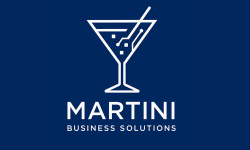Philip Martini • July 12, 2025
The Truth About Google Business Profiles: Are You Using Yours to Its Full Potential?
If you’re a small business owner, your Google Business Profile (GBP) is one of your most powerful (and free) marketing tools. Yet, many businesses don’t use it to its full potential—missing out on calls, leads, and foot traffic simply because their profile isn’t optimized.
At Martini Business Solutions, we’ve seen firsthand how a well-managed GBP can transform local lead generation without increasing your ad spend. Here’s what you need to know to ensure your Google Business Profile is working for you, not against you.
What Is a Google Business Profile?
Your Google Business Profile is the listing that shows up when someone searches for your business or services near them on Google or Google Maps. It displays your:
✅ Business name
✅ Address and service areas
✅ Phone number and website
✅ Photos and videos
✅ Reviews
✅ Posts and updates
Think of it as your digital storefront for local customers ready to take action.
Why Is Your Google Business Profile So Important?
Over 70% of consumers research businesses online before making a decision. A complete, optimized Google Business Profile:
✔️ Increases your visibility in local search results
✔️ Builds trust with customers through reviews and updated information
✔️ Makes it easy for customers to call, message, or visit your website
✔️ Provides insights on how customers find and interact with your business
Common Mistakes Businesses Make with Their GBP
Many businesses simply “claim” their profile and leave it. Here are common mistakes we see:
🚩 Using outdated business hours or contact info
🚩 Missing photos (or using low-quality images)
🚩 Not posting updates or promotions
🚩 Failing to respond to reviews (both good and bad)
🚩 Not adding services, service areas, or products
These issues may seem small, but they can hurt your rankings and reduce customer trust.
How to Optimize Your Google Business Profile
Ready to level up your GBP? Here’s what to do:
✅ Complete every section (services, products, business description, hours, contact info).
✅ Add high-quality photos of your work, your team, and your location regularly.
✅ Collect and respond to reviews to build credibility and engagement.
✅ Post updates weekly about your services, promotions, or seasonal tips.
✅ Use keywords your customers are searching for in your business description and posts.
✅ Check your insights to see what people are searching for and adjust your strategy accordingly.
The Results: What an Optimized GBP Can Do for Your Business
We’ve helped clients across fencing, junk removal, and dental practices increase:
📈 Visibility in Google Maps and “near me” searches
📈 Call volume and website clicks
📈 Local leads without increasing ad spend
Your Google Business Profile isn’t just a listing; it’s a lead-generation engine when used properly.
Ready to Get More Leads from Google?
At Martini Business Solutions, we help small businesses like yours optimize their Google Business Profiles to drive consistent leads without wasted marketing dollars.
📲 Want us to review and optimize your GBP for you?
📩 Send us a message [here] or email phil@tinibiz.com to book your free Google Business Profile audit.

We live in a world that moves fast — business deadlines, family obligations, side hustles, and everything in between. But here’s the truth: success doesn’t come from chaos. It comes from alignment — firing on all cylinders across every area of your life. At Martini Business Solutions, we don’t just believe in marketing smarter — we believe in living smarter. 🧠 1. Mental Health: The Engine That Drives It All You can’t build a high-performing business if your mind is running on fumes. Taking time to reset — whether it’s a morning walk, journaling, or simply stepping away from your phone — is just as important as your next marketing campaign. A strong mind equals clear decisions. And clear decisions drive better results. 🏋️♂️ 2. Physical Health: The Fuel for Consistency Energy is your competitive advantage. When you take care of your body — eating right, working out, sleeping well — you perform better in every role: entrepreneur, leader, parent, or partner. Think of your health as your personal operating system. If it crashes, everything else follows. 💼 3. Professional Growth: Sharpen the Skillset The best business owners are lifelong learners. Just like engines need tune-ups, your skills need upgrades. Whether it’s learning AI tools, refining your marketing strategy, or exploring automation, investing in yourself compounds over time. At Martini Business Solutions, we help home service businesses and entrepreneurs work smarter, not harder — building digital systems that create freedom, not burnout. 🏡 4. Home & Leisure: Recharge to Perform Hustle is great, but rest is what keeps your hustle alive. Spend time with family, enjoy hobbies, or simply disconnect for a weekend. Balance isn’t laziness — it’s sustainability. The same goes for your business: if your marketing isn’t automated, it’s probably draining your energy. We help home service businesses automate repetitive tasks, so you can focus on what matters — living life fully. ⚙️ Firing on All Cylinders = Longevity When all areas of your life are aligned, you operate with purpose, clarity, and drive. That’s true for humans — and it’s true for businesses. At Martini Business Solutions, we help companies build marketing systems that run as smoothly as a well-tuned engine. From websites and SEO to automation and analytics — our goal is simple: Better Marketing. Less Waste. Real Results. 🔗 Ready to Fire on All Cylinders? Visit www.tinibiz.com to learn how we can help you create balance, build growth, and keep your business performing at its peak.
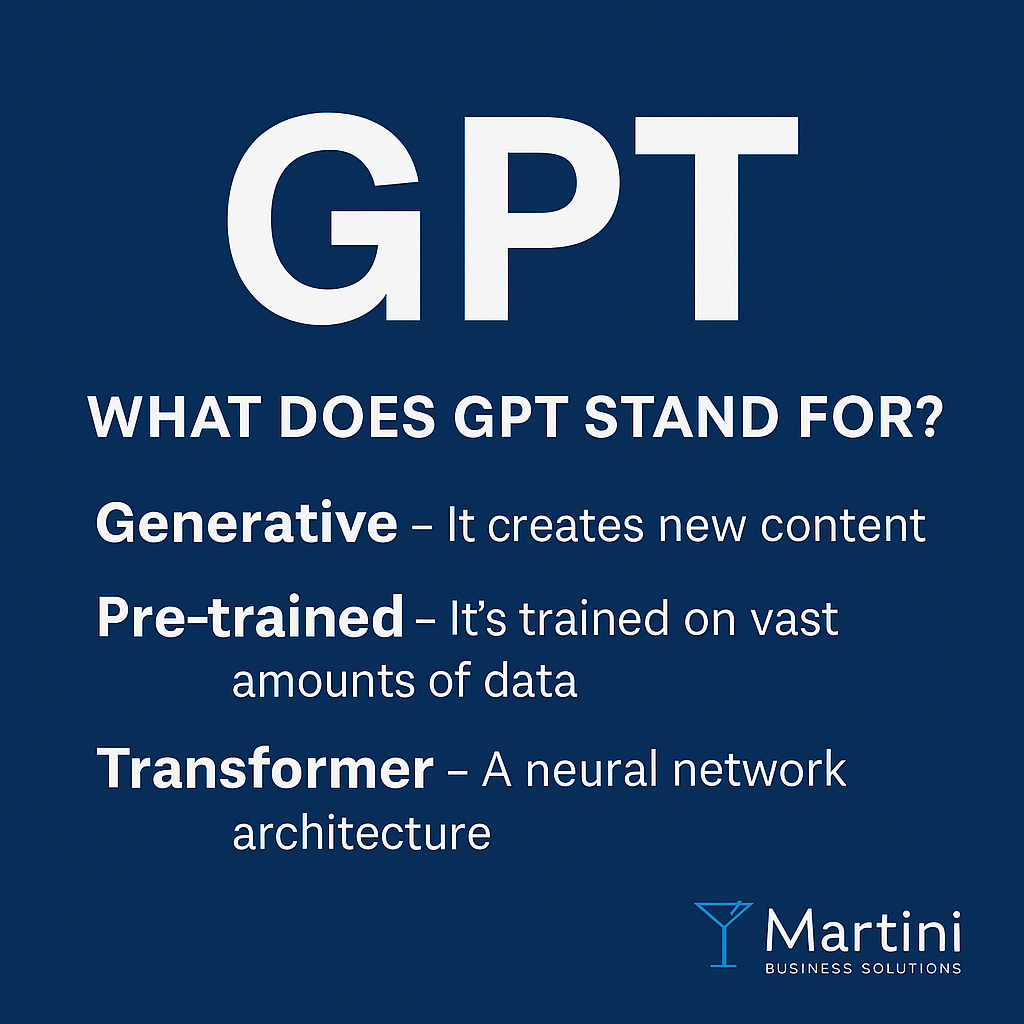
Most people have heard of ChatGPT by now. It’s on the news, in classrooms, and in boardrooms — but few people actually know what the “GPT” part means. Let’s clear that up. What GPT Really Stands For GPT stands for Generative Pre-trained Transformer — three words that describe how modern AI actually thinks and creates. Generative → It doesn’t just retrieve data — it creates new content, whether that’s text, ideas, or code. Pre-trained → The model is trained on billions of examples — books, articles, conversations — so it understands language before you ever use it. Transformer → This is the secret sauce — an advanced neural network developed by Google in 2017 that allows the AI to grasp context and relationships between words the same way humans do. In short: GPT is a language-understanding engine that can communicate, reason, and create — not just compute. A Quick Origin Story GPT was developed by OpenAI, a research company founded in 2015 with a simple mission: to make artificial intelligence accessible and beneficial to everyone. Before GPT, AI models were like one-trick ponies — great at specific tasks like detecting spam or recognizing images. GPT changed everything by creating a general-purpose model capable of learning almost any language-based task. Over time, that model evolved into what we know today: GPT-1 (2018) : Small, experimental, and proof that language could be learned. GPT-2 (2019) : Shockingly fluent — so much so that OpenAI initially kept it private. GPT-3 (2020) : Massive jump forward. 175 billion parameters. AI could write blogs, code, and hold full conversations. GPT-4 (2023) : Smarter, multimodal, and far more accurate. It could process images and context seamlessly. GPT-5 (2025) : The era of custom GPTs — specialized assistants that can be trained to fit your exact business or workflow. Each generation didn’t just get better — it got more usable. Today, anyone can use GPT tools to perform tasks that once required entire teams. Why GPT Technology Matters for Small Businesses Artificial intelligence isn’t just for tech giants anymore — it’s becoming the ultimate equalizer for small businesses. If you run a fencing company, dental practice, or moving service, you already juggle 10 different roles. GPT can now automate some of those jobs so you can focus on what matters most — serving customers and growing revenue. Here’s what that looks like in practice: 💬 Communication Automation Send personalized follow-ups to missed calls or web form leads instantly. 🧾 Content Creation Generate Google posts, blog articles, email newsletters, and social captions in minutes — not hours. 📅 Scheduling & Admin Tasks Integrate GPT with your booking tools to confirm appointments, answer FAQs, or send reminders automatically. 📈 Smarter Decisions Use AI insights to understand where your leads come from, how they convert, and where you can save money. 💰 Real Cost Savings Spend less on outside marketing agencies and do more in-house with AI assistance. For home service and local business owners, GPT can serve as a 24/7 assistant — writing, planning, and analyzing so you don’t have to. The Risk of Ignoring AI Think back to when websites or social media first became essential for business. Those who adapted early thrived. Those who didn’t… played catch-up for years. AI is the next leap. And it’s moving much faster. In the next few years, businesses that haven’t built AI into their operations — even at a basic level — will struggle to compete on speed, efficiency, and visibility. This isn’t about replacing people. It’s about giving small business owners leverage — the kind big corporations have had for years. The Human + AI Partnership AI doesn’t remove creativity — it amplifies it . Think of GPT as your tireless digital teammate: You bring the ideas, strategy, and personal touch. GPT brings the speed, scale, and consistency. A quick example: You sketch out an idea for a new blog post or ad campaign. GPT drafts it, formats it, and helps with the visuals. You polish it and publish within an hour. That’s what business growth looks like when humans and AI work together. How to Learn and Apply GPT in Your Business That’s exactly what I teach inside The Profit From Anywhere (PFA) Academy — how to use GPT and AI tools to: ✅ Build and automate professional websites ✅ Create digital real estate that generates leads ✅ Run ads and manage client campaigns ✅ Automate follow - ups and increase close rates ✅ Grow without adding extra staff Whether you’re a solo entrepreneur or running a small team, AI gives you the systems to scale without the chaos. 👉 Explore how GPT can power your business at www.tinibiz.com and start building your digital advantage today.

When most people hear the term “AI,” their minds immediately go to ChatGPT — a tool that can write essays, build websites, and hold conversations. But artificial intelligence has a much deeper and more fascinating history — one that stretches back nearly a century and continues to reshape every corner of business and daily life. The Origin of Artificial Intelligence Artificial Intelligence, as an academic concept, was born in 1956 at Dartmouth College, where a group of scientists and mathematicians set out to explore the possibility of “machines that could think.” Early AI systems were incredibly limited — capable of simple mathematical reasoning or playing basic games like checkers and chess. Through the 1960s and 1970s, researchers dreamed of human-level reasoning, but the computing power of the time couldn’t keep up. The field entered a period known as the “AI Winter,” where funding dried up and progress stalled. The Reawakening: Machine Learning and Big Data Fast forward to the 1990s and early 2000s — AI was reborn through a new approach called machine learning. Instead of trying to explicitly program intelligence, scientists began training computers using data — allowing machines to recognize patterns and make predictions. This evolution coincided with the explosion of the internet and massive data storage capabilities. Suddenly, computers could “learn” from billions of examples — photos, text, sounds, and videos — and produce shockingly accurate results. The AI Boom: Neural Networks and Deep Learning By the 2010s, neural networks — algorithms inspired by the human brain — began powering modern AI. From Siri and Alexa to Google Translate and Tesla’s autopilot, deep learning revolutionized what technology could do. Then came Generative AI — models that didn’t just analyze data, but created new things. Text, art, code, music, video — AI could now imagine. When ChatGPT launched in late 2022, it became the fastest-growing technology adoption in human history. Millions began experimenting with it — writers, entrepreneurs, teachers, and developers — turning once-complex tasks into a few typed prompts. The Risks: Automation Anxiety and Ethical Dilemmas Like every technological revolution, AI brings both opportunity and uncertainty. Many fear AI will replace jobs — and in some sectors, it will. Repetitive, rule-based work is being automated faster than ever. But history tells us: technology doesn’t just replace jobs — it transforms them. The invention of electricity wiped out thousands of candle makers, but gave rise to engineers, electricians, and entire new industries. AI is on the same path — shifting value from manual repetition to creativity, problem-solving, and human connection. The real challenge isn’t AI itself — it’s how we adapt. There are also ethical and existential questions: How do we ensure AI isn’t biased or manipulative? How do we maintain privacy in an AI-driven world? What happens when machines can simulate human emotion or decision-making? These questions don’t have easy answers. But they do demand participation — from creators, regulators, and users alike. The Rewards: Acceleration of Human Potential Despite the risks, AI represents one of the greatest accelerators of human potential ever created. For small businesses, entrepreneurs, and creators, AI is the ultimate force multiplier. It can: ✅ Write marketing campaigns ✅ Design websites ✅ Automate customer follow-ups ✅ Create videos, graphics, and blog content ✅ Analyze sales data and predict trends In short, AI allows you to do in hours what used to take weeks. This means individuals — not just corporations — can now compete at a global level. The barriers to entry are lower than ever before. How AI Is Reshaping the Workforce We’re entering the age of augmented work — where AI handles the heavy lifting , and humans focus on higher-order thinking . Jobs that combine technical efficiency and human creativity are skyrocketing in demand : AI marketing strategists Digital asset creators Automation consultants Virtual business builders The traditional 9-to-5 is evolving into something more flexible, entrepreneurial, and digital. For many, AI is the bridge between financial survival and financial independence. The Future of AI: Where It’s All Headed AI won’t just assist us — it will soon collaborate with us. We’ll have AI teammates, AI-powered small businesses, and even AI-driven education systems. Entire industries will run on intelligent automation — healthcare, construction, finance, marketing, and local services. But the true winners will be those who understand how to own the systems instead of just using them. That means building digital assets that work 24/7 — websites, funnels, automations, and data-driven online brands. Your Opportunity: Learn to Leverage AI for Digital Real Estate At The PFA Academy, we’re teaching everyday people how to turn AI from a curiosity into cash flow. You don’t need a tech background. You don’t need years of coding experience. You’ll learn how to: 💻 Build and rent websites using AI tools 📈 Support real home-service businesses with better sales and marketing 🏠 Create digital “real estate” that earns passive or semi-passive income The same way physical real estate builds wealth through ownership, digital real estate builds wealth through automation and visibility. It’s time to stop just watching the AI revolution — and start owning a piece of it. Ready to Build Your Future? As 2025 comes to a close, ask yourself: Are you watching AI change the world — or are you leveraging it to change yours? 👉 Join The PFA Academy and learn step-by-step how to build your first AI-powered digital asset, support real small businesses, and create income streams that don’t require sacrificing family time. Start stacking your digital assets today. Start stacking your future. 🔗 www.tinibiz.com | Powered by Martini Business Solutions
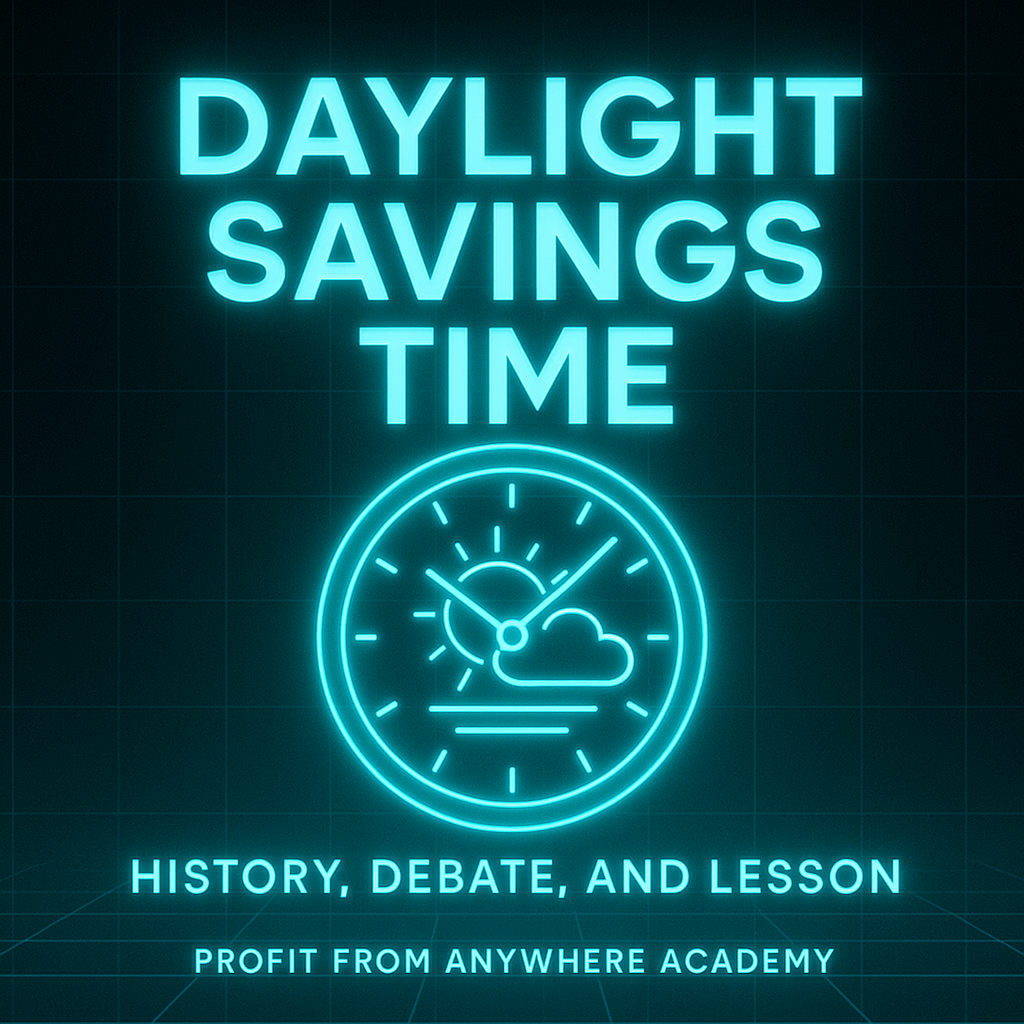
Every March and November, people across the U.S. adjust their clocks for Daylight Savings Time (DST). Some love the extra evening light, others dread the lost hour of sleep — but everyone feels the impact. But where did Daylight Savings Time come from? Why does it still exist? And what does it teach us about how we value time and freedom? Let’s break it down — and I’ll show you how this connects to creating financial freedom with The Profit From Anywhere Academy. A Quick History of Daylight Savings Time The concept of Daylight Savings was first popularized in the early 1900s as a way to save fuel and energy by making better use of natural light. World War I & II: Countries adopted DST to conserve fuel during wartime. 1966: The U.S. standardized the practice with the Uniform Time Act. Today: Not every state follows DST, and debates about its usefulness are ongoing. Search terms like “when did daylight savings start” or “why was daylight savings created” all point back to this history of energy savings and efficiency. Should We Keep Daylight Savings Time? The debate is stronger than ever: Arguments for Daylight Savings Time: Longer daylight hours in the evening. Encourages outdoor activities. Boosts retail and recreation industries. Arguments Against Daylight Savings Time: Sleep disruption and health risks. Minimal energy savings in modern times. Confusing clock changes twice a year. Many states have already passed legislation to either end DST or make it permanent, but federal approval is still needed. If you’ve ever Googled “should daylight savings be abolished”, you know this conversation isn’t going away. The Bigger Lesson About Time Here’s the truth: time is man-made. We lose or gain an hour not because of nature — but because society agreed to change the clock. Daylight Savings reminds us that the systems we live by aren’t fixed. They’re created. And if time systems can be created, so can income systems . That’s where the Profit From Anywhere Academy comes in. Profit From Anywhere Academy: Take Back Your Time In The Profit From Anywhere Academy (PFA Academy), we teach people how to build digital real estate assets — websites and marketing funnels that generate leads for home service businesses. Why does this matter? Because most people live by someone else’s clock: The 9–5 grind. Limited vacation days. Hoping for a promotion just to “buy back” time later. But by learning how to build and rent out digital assets, you can: Create semi-passive income streams. Work from anywhere in the world. Take control of your schedule and your freedom. Take Action Today Daylight Savings Time may stay or go, but one fact won’t change: your time is the most valuable asset you have . Instead of waiting for more daylight, start designing a life where you control your income and your hours. 👉 Ready to learn how? Join The Profit From Anywhere Academy today and start building your first digital real estate asset. 📌 Visit www.tinibiz.com to get started today!
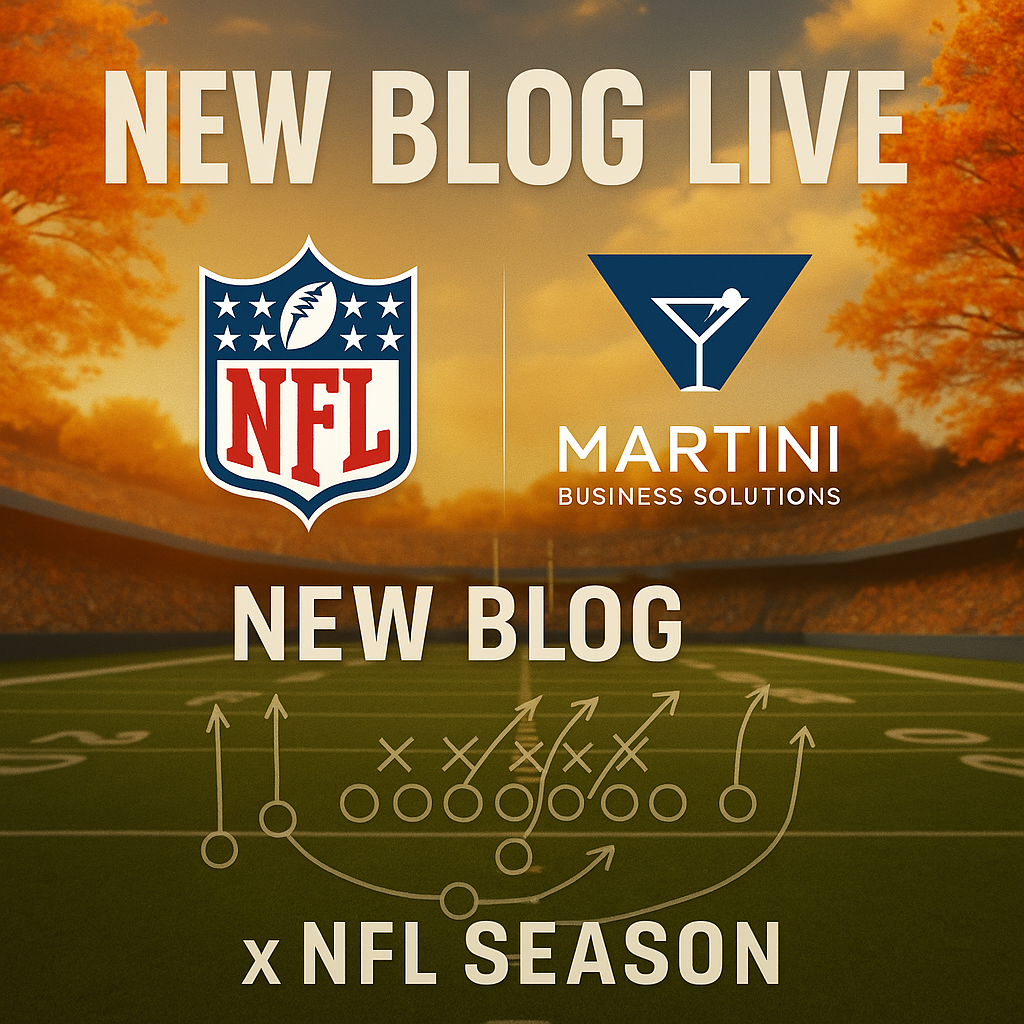
It’s football season, and while fans are breaking out their jerseys, wings, and fantasy lineups, small business owners should be thinking about their own playbook. Running a business in today’s digital world is a lot like playing in the NFL — success comes down to preparation, execution, and having the right game plan. At Martini Business Solutions , we help small businesses turn digital chaos into clear, winning strategies. And through The PFA Academy (Profit From Anywhere Academy), we train aspiring entrepreneurs to build digital assets and generate semi-passive income that stacks up like championship rings. 1. Every Team Needs a Playbook (Your Marketing Strategy) NFL teams don’t just show up on Sunday and hope for the best — they have a game plan designed to exploit opportunities and outplay the competition. For small businesses, your marketing playbook is your website, SEO, Google Business Profile, and lead generation system. Without it, you’re running random plays with no chance of scoring. At Martini Business Solutions, we build custom marketing playbooks that help local businesses: Rank in Google’s “Top 3” Map Pack Generate inbound calls and web form leads Track, measure, and improve ROI Automate customer follow-ups 2. Defense Wins Championships (Protecting Your Brand) In football, a strong defense keeps your opponent from scoring. For businesses, “defense” means protecting your reputation and online visibility. If your information is inconsistent across Google, Yelp, and directories, or if you’re not collecting reviews, you’re leaving your business wide open for competitors to steal the win. We make sure your Name, Address, and Phone (NAP) are consistent, reviews are actively managed, and your online presence is always protected — so you stay in control of the scoreboard. 3. Special Teams Make the Difference (Small Tweaks, Big Wins) Games are often won or lost on a single kick return or blocked punt. Similarly, small digital tweaks can create huge wins for your business: Adding click-to-call buttons on mobile websites Optimizing photos with proper alt-text Running hyper-local Google Ads with seasonal offers These “special teams” plays often separate businesses that survive from those that dominate. 4. Building a Dynasty (Digital Assets That Pay Forever) The Patriots didn’t just win once — they built a dynasty. Businesses and entrepreneurs can do the same by stacking digital assets. Through The PFA Academy, we teach students how to: Build and launch lead generation websites in profitable niches Monetize them by renting leads to local contractors Use AI tools and automation to scale Create multiple income streams that grow year after year Instead of waiting for a “Hail Mary,” our students build consistent, reliable revenue streams — the digital equivalent of a powerhouse dynasty. 5. The Two-Minute Drill (Stop Waiting, Start Now) In football, the two-minute drill is all about urgency. The clock is ticking. For small businesses, every day you’re not building your digital presence, you’re falling behind. The good news? Martini Business Solutions and The PFA Academy are here to coach you. Whether you’re a small home service business looking for more leads or an aspiring entrepreneur ready to build your first digital asset, the time to take the field is now. Conclusion Football season is about more than touchdowns and tailgates — it’s a reminder that success requires a game plan, teamwork, and execution. At Martini Business Solutions, we help small businesses dominate their local markets. And through The PFA Academy, we show everyday people how to build semi-passive income streams through digital real estate. So while you’re cheering on your favorite NFL team this fall, ask yourself: What’s my playbook for financial freedom and business growth? 📲 Contact us today at www.tinibiz.com to start building your winning strategy.
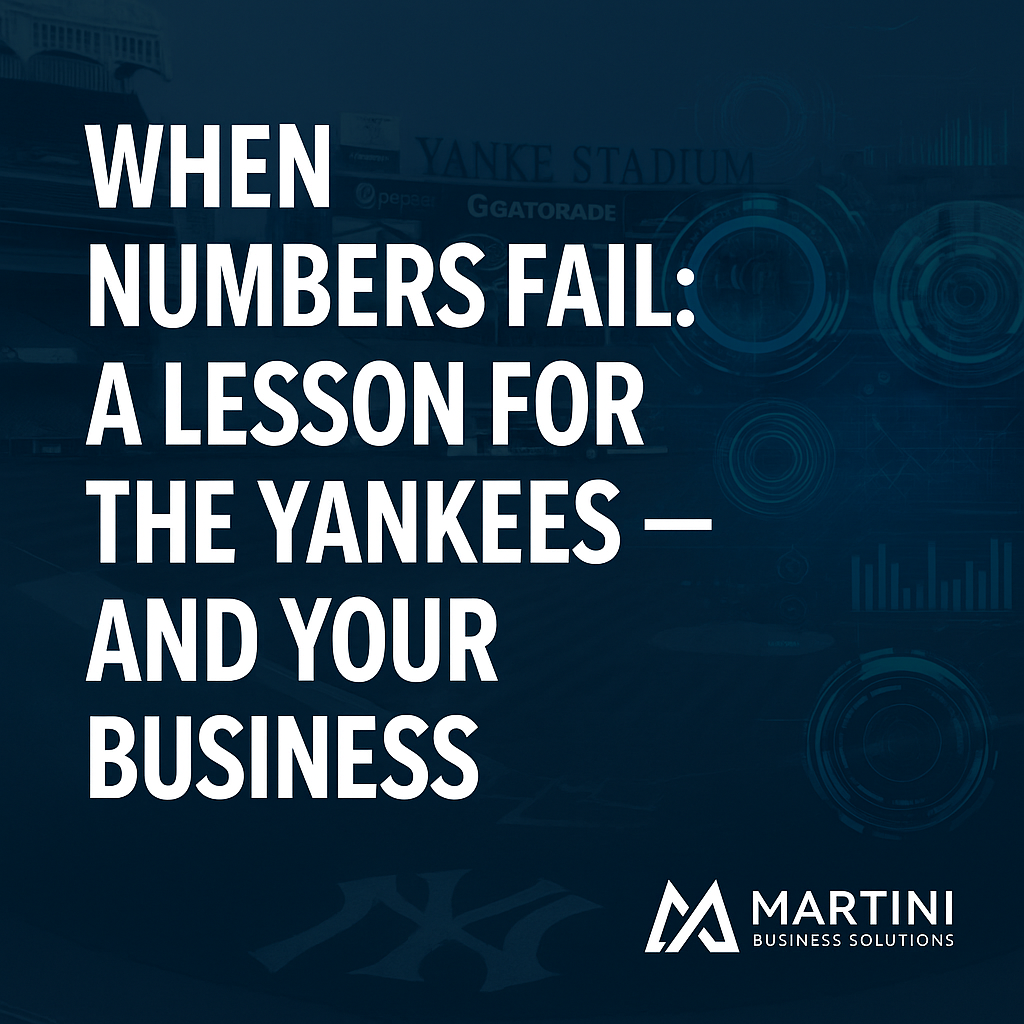
The New York Yankees have long been baseball’s gold standard — built on instinct, swagger, and a relentless drive to win. But in 2025, that edge feels… dulled. Why? A heavy — almost blind — overreliance on analytics. And while this problem is playing out in the Bronx, it’s a story that resonates far beyond baseball — especially in business, marketing, and digital entrepreneurship, where I see this same mistake every single day. The Spreadsheet Trap In today’s MLB, the Yankees run nearly every decision through advanced metrics: launch angle, exit velocity, WAR, spin rate. Sounds smart, right? Here’s the catch — numbers are only part of the picture . Baseball players aren’t machines, and neither are your customers or prospects. You can’t track confidence, grit, adaptability, or timing in a spreadsheet. At Martini Business Solutions and through the PFA Academy, I teach this balance every day: data informs decisions, but human instincts close deals. Metrics guide us, but without intuition and context, you risk making decisions that look good on paper but fail in the real world. Over-Analyzing Your "Lineup" This trap isn’t unique to baseball. In business, over-analyzing can look like: Overcomplicating ad campaigns with too many KPIs that confuse rather than clarify. Obsessing over CTR or CPA while ignoring what your audience is actually telling you. Forgetting the simple, human conversations that drive referrals, reviews, and repeat business. Like the Yankees’ “home-run or bust” approach, a business that leans solely on data without human context becomes one-dimensional. When market conditions shift, competitors adapt faster. When customer behavior changes, leads dry up. In those moments, adaptability — not just analytics — keeps you winning. Why Balance Wins The most successful organizations marry numbers with nuance: Track the right data, but don’t ignore what you’re hearing from the field. Use automation tools like our WebPro Marketing Suite to streamline operations, but keep the personal touch that builds lasting relationships. Lean into trends and analytics, but always be ready to test, pivot, and trust your instincts — fast. In The PFA Academy , when we teach students how to build and monetize digital real estate assets, this principle is at the core: success comes from balancing the science of data with the art of execution. The Bigger Picture What makes this lesson so important is that it applies to every level of business. Whether you’re a solopreneur building your first lead-gen site, a marketing director managing multi-channel ad campaigns, or a sales rep trying to hit quarterly numbers — the ability to combine insights with intuition will always set you apart. Analytics will show you what’s working, but your gut — refined through experience and observation — tells you why it’s working and how to scale it. The Takeaway The Yankees’ roster looks great on paper, but in the moments that matter — October baseball — numbers alone don’t win rings. The same is true in business. If you’re running ads, building websites, or scaling digital assets, don’t make the same mistake. Pair your analytics with real-world action, feedback, and adaptability. Because when numbers and instincts align, that’s when you win — in baseball, in business, and in building the life you want. Ready to balance your data with strategy? Visit www.tinibiz.com to learn more about Martini Business Solutions and the PFA Academy, where we help you turn digital assets into real-world revenue. #MartiniBusinessSolutions #PFAAcademy #DigitalRealEstate #DefineYourAnywhere #Yankees
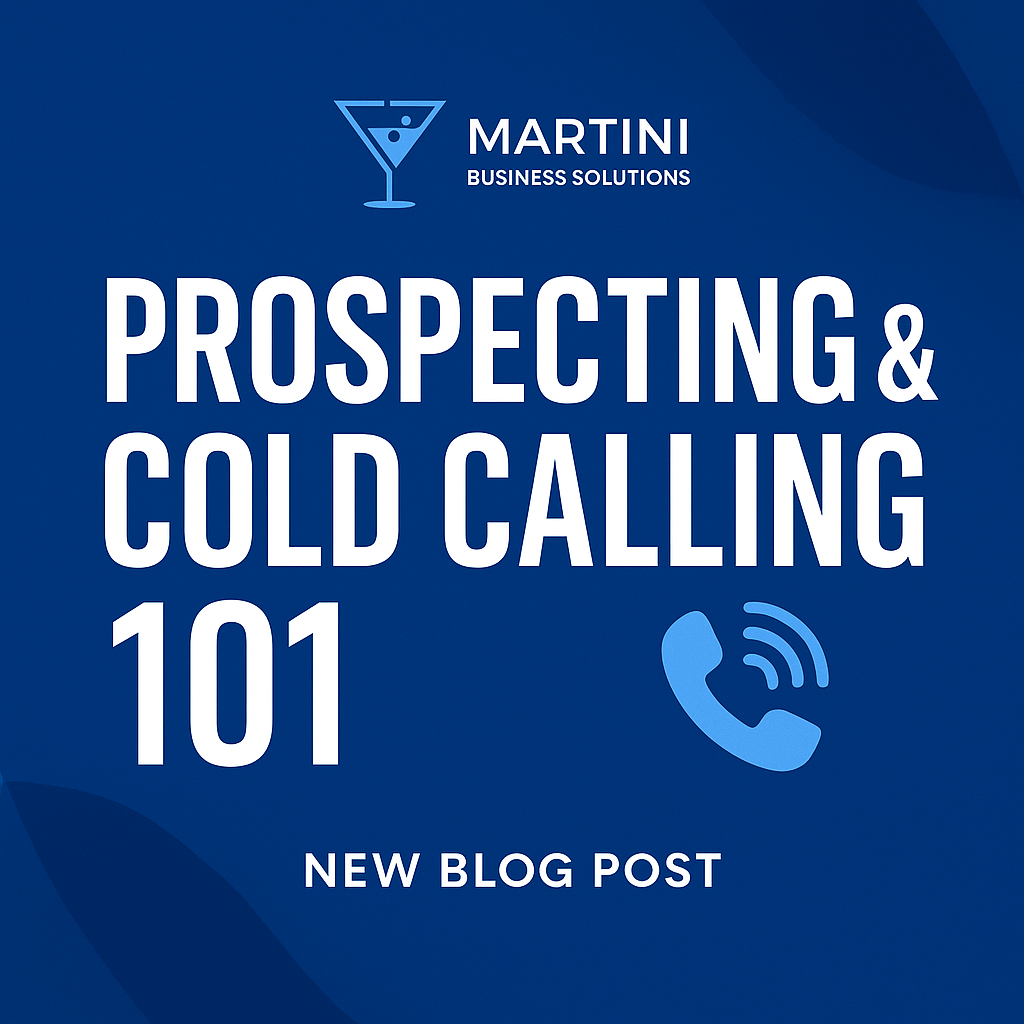
Every business wants more customers. But let’s be real—getting them isn’t always easy. You can spend thousands on ads, post on social media every day, and still wonder why the phone isn’t ringing. That’s where prospecting and cold calling come in. Whether you’re a small business owner or a brand-new salesperson, learning how to prospect the right way can transform your growth. In this post, we’ll break down the basics of prospecting, show you where most businesses go wrong, and give you a roadmap to fix it. What Is Prospecting, Really? Prospecting is simply the act of identifying potential customers who may need your service. Cold calling (or cold outreach in general) is the process of reaching out to those people before they know you. Think of it this way: Prospecting = finding the right people Cold calling = starting the conversation When done right, prospecting isn’t about being pushy. It’s about connecting with people who already have a problem you can solve. The 3 Biggest Prospecting Mistakes Businesses Make Here’s where most businesses hit a wall: 1. Casting Too Wide a Net If you’re trying to sell to “everyone,” you’ll end up convincing no one. Instead, narrow your focus. For example, a fencing contractor should target homeowners in neighborhoods built 10–15 years ago, where fences are aging. 👉 Fix : Create an ideal customer profile—location, age, income bracket, business type, etc.—and prospect only within that lane. 2. Not Tracking Outreach Many businesses make 10 calls, send 3 emails, and call it a day. The problem? They don’t track who responded, who needs follow-up, or where leads came from. 👉 Fix : Use a simple CRM (customer relationship management system) to log every call, text, and email. Consistency compounds. 3. Giving Up Too Soon Most sales don’t happen on the first call. In fact, research shows it often takes 5–7 touches before a lead is ready to buy. 👉 Fix : Build a follow-up sequence. That could mean a phone call today, a text tomorrow, an email in 3 days, and a check-in the following week. Persistence wins. Cold Calling 101: How to Do It Without Feeling “Salesy” Cold calling doesn’t have to feel like begging for business. Here’s a simple 4-step framework: Warm Up Your List Don’t just dial random numbers. Do a little research—find businesses that match your target customer profile. Open With Value, Not a Script Instead of “Hi, I’d like to tell you about my services…” try: “Hi [Name], I noticed you’ve been [specific observation about their business or industry]. I work with companies like yours to solve [problem]. Curious—how are you currently handling that?” Listen More Than You Talk The best salespeople ask good questions and let the prospect explain their needs. End With a Clear Next Step Don’t hang up without a plan. Whether it’s scheduling a follow-up call, sending info, or booking a demo—always secure the next action. Why This Matters for Your Business If your sales pipeline feels empty, chances are the problem isn’t your product—it’s your prospecting. A well-structured prospecting process ensures you’re always filling the pipeline with fresh opportunities. And here’s the kicker: you don’t need to be a “natural-born salesperson” to succeed. Prospecting and lead generation are skills anyone can learn. How The PFA Academy Can Help At The PFA Academy (Profit From Anywhere Academy), we don’t just teach digital marketing—we also teach sales skills like prospecting, cold calling, and lead generation. Why? Because a beautiful website and clever ads mean nothing if you can’t convert leads into paying customers. Through our training, you’ll learn how to: ✅ Build prospect lists that actually convert ✅ Master cold calling without feeling pushy ✅ Create outreach systems that run on autopilot ✅ Turn sales skills into a business of your own—helping other businesses grow Whether you’re an entrepreneur, freelancer, or someone looking for a side hustle, these are skills that can pay you for life. Final Thoughts Prospecting isn’t about annoying strangers—it’s about solving problems for people who need you. If you can learn to identify the right people, start authentic conversations, and follow up with consistency, you’ll never run out of opportunities. And if you want to master these skills and apply them in your own business—or even build a career helping others—The PFA Academy is where you start. 👉 Ready to learn sales and marketing the right way? Check out The PFA Academy
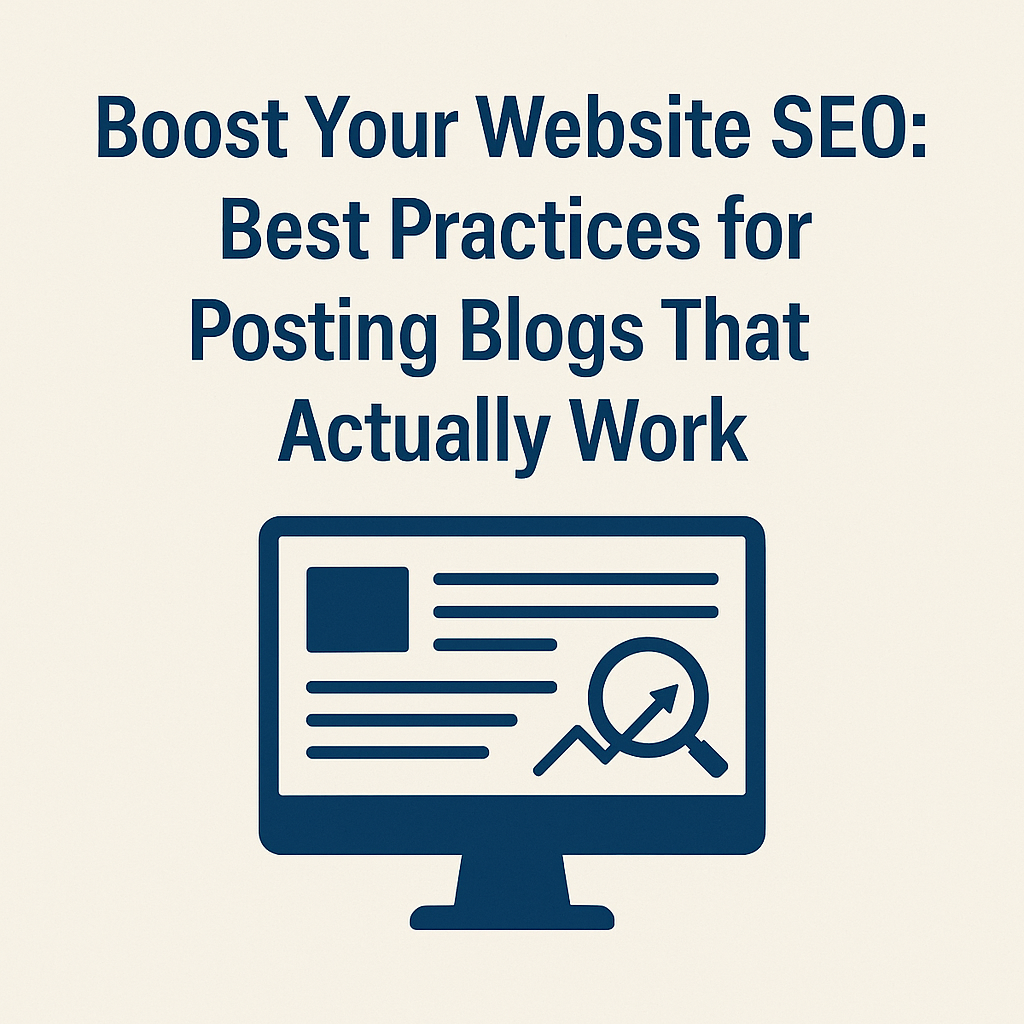
If you want to rank higher on Google, attract the right audience, and turn website visitors into paying customers, posting blogs the right way is one of the most effective strategies you can use. But just writing random articles isn’t enough—you need a plan. At Martini Business Solutions , we help small businesses create and maintain SEO-friendly websites that consistently drive traffic and leads. Here’s a breakdown of best practices for posting blogs to help your website SEO, plus how we can take this off your plate entirely. 1. Post Content That Solves Problems & Matches Search Intent Google’s #1 goal is to deliver the most relevant content to the person searching. That means your blogs should answer questions your audience is already asking. Examples: A fencing company could post: “How to Choose the Right Fence for Your Backyard” A dental practice could post: “5 Signs You Might Need a Dental Crown” A moving company could post: “How to Pack Fragile Items for a Move” Tip : Use free tools like Google’s “People Also Ask” or keyword research tools to find exactly what people are searching for in your niche. 2. Maintain a Consistent Posting Cadence Search engines love fresh content. A regular posting schedule shows Google your site is active and trustworthy. Minimum: 1–2 posts per month Ideal: 1 post per week Aggressive growth: 2–3 posts per week Even if you can’t post often, consistency is more important than volume. 3. Use Keyword Optimization Without “Stuffing” Keywords tell search engines what your blog is about, but overloading them can hurt your ranking. Best practices: Include your main keyword in the title, first paragraph, and 1–2 subheadings. Sprinkle related phrases (secondary keywords) naturally throughout the article. Add your keyword to your URL, meta description, and image alt text. Example: Instead of writing “We are the best Raleigh fence company” 20 times, mix it up with phrases like “top-rated fencing contractor in Raleigh” or “backyard fence installation experts.” 4. Write Longer, More Valuable Content Blog posts over 1,000 words tend to perform better for SEO because they provide more in-depth answers. Just make sure every section offers value—fluff won’t help. 5. Don’t Forget Internal & External Links Linking to other pages on your own website helps guide visitors through your content and keeps them on your site longer (a signal Google likes). Linking to reputable external sites can also boost credibility. 6. Promote Your Blogs Beyond Your Website Publishing a blog is only step one. Share it on: Google Business Profile Facebook, Instagram, LinkedIn Email newsletters Local business directories or industry forums The more places your blog is seen, the more traffic (and potential backlinks) it will generate. How Martini Business Solutions Can Do This for You At Martini Business Solutions , we don’t just build SEO-friendly websites—we help you dominate your market with an ongoing content strategy. Our blog posting and SEO management services include: Keyword research specific to your business and location SEO-friendly blog writing that ranks and converts On-page optimization (meta tags, headings, image alt text) Content calendar creation to keep posts consistent Monthly analytics tracking so you see what’s working Website updates & SEO maintenance to keep your site at peak performance Whether you want to post twice a month or multiple times a week, we can handle the content creation, posting, and optimization so you can focus on running your business. ✅ Ready to boost your website traffic and leads? Contact us today to start building a blog strategy that puts your business on top of Google. EXCLUSIVE OFFER FOR PROSPECTIVE PFA ACADEMY STUDENTS - Mention this blog post and get 90 free days of The PFA Academy Courses + 1 month free of WebPro CRM/Website Builder! Call us now!
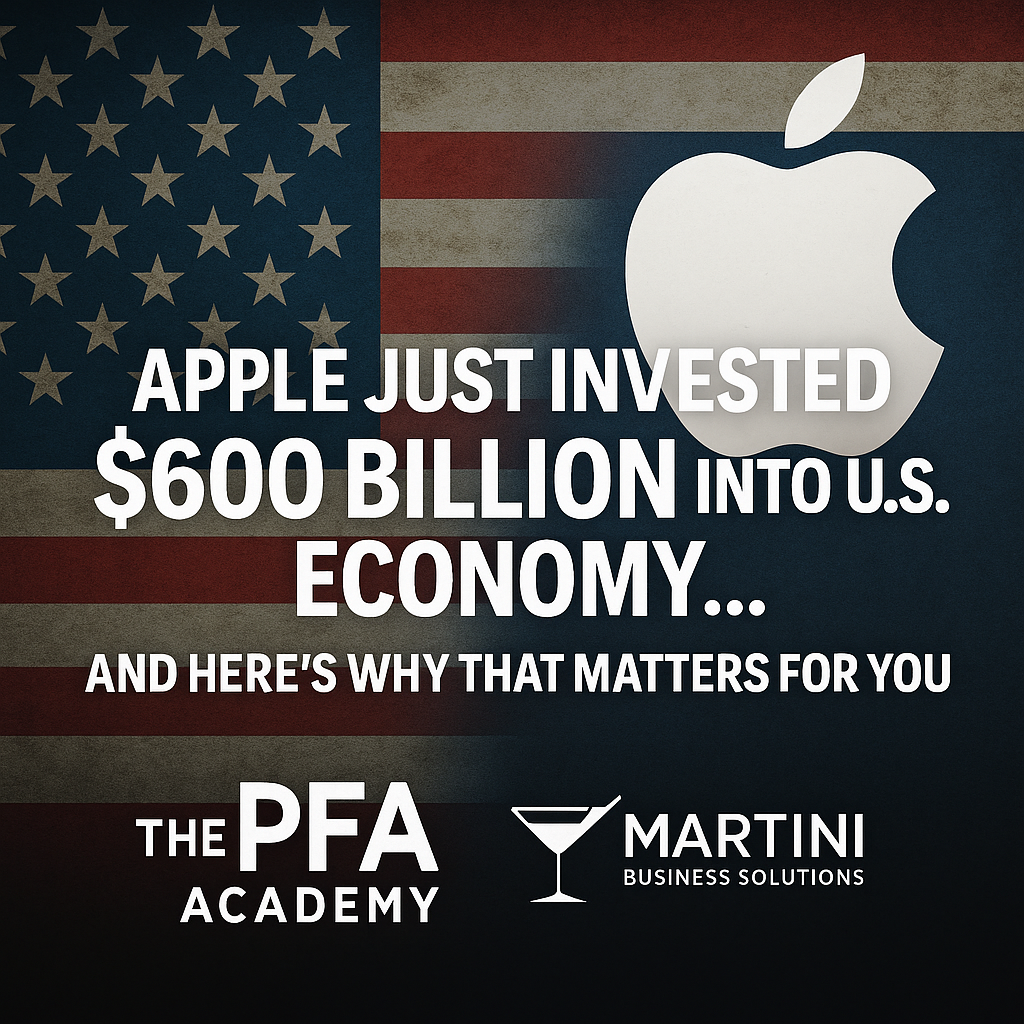
Apple has just announced something unprecedented — it’s increasing its total U.S. investment commitment to $600 billion . This is not just about tech products. It’s about jobs, infrastructure, innovation, and reshaping the American economic landscape for decades to come. From building new advanced manufacturing facilities to expanding data centers and creating tens of thousands of jobs, this is a long-term, high-confidence bet on America’s ability to innovate, produce, and grow. But here’s the question most people aren’t asking: If Apple is doubling down on investing in America… why aren’t you? 🍏 Inside Apple’s $600B Commitment While Apple is famously tight-lipped about its future products, it’s clear about its investment roadmap. According to their announcement, the $600 billion will go toward: Advanced Manufacturing – Building new facilities for cutting-edge product assembly and component manufacturing right here in the U.S. Clean Energy & Sustainability – Expanding renewable energy projects to power Apple’s operations and partners. Data Centers & Infrastructure – Increasing capacity to support iCloud, Apple Music, Apple TV+, and other services. Job Creation – Tens of thousands of new jobs in engineering, manufacturing, and support roles. Education & Workforce Development – Investing in programs that train the next generation of American innovators. This isn’t just a feel-good PR move. Apple’s investment strengthens supply chains, boosts local economies, and keeps innovation anchored in the U.S. 📈 Why This Matters to You Most of us won’t be building billion-dollar factories. But the principles behind Apple’s investment apply at every level: Invest Where You Can Control the Outcome - Apple is keeping production close to home, where it can maintain quality and oversight. You can do the same by building digital assets you fully own. Bet on Long-Term Growth - This isn’t a quick win for Apple. It’s a multi-decade strategy. Likewise, digital real estate can produce steady returns for years when set up correctly. Support the Local Economy - Apple’s investments ripple outward — benefiting suppliers, contractors, and communities. When you build digital lead generation websites for local service businesses, you create similar economic ripples. 🌐 The Connection to The PFA Academy At The PFA Academy, our mission is to teach people how to create digital real estate that works exactly like physical real estate — but without the huge startup cost, repairs, or tenants. We help you: Identify high-demand U.S. service markets (fencing, roofing, painting, plumbing, etc.) Build high-converting websites that attract customers in those markets Drive traffic through Google Ads and SEO Partner with local businesses who pay you per lead or on a monthly rental basis Just like Apple is expanding its U.S. infrastructure, we’re helping our students expand digital infrastructure — websites and online funnels that support American small businesses. 💡 Why Now Is the Time Apple’s $600B move tells us two things: Confidence is high in the American economy. They wouldn’t be spending this much here if they didn’t see a massive return potential. The best opportunities are still at home. Whether it’s manufacturing or marketing, building in the U.S. means stronger relationships, better oversight, and lasting growth. Digital assets follow the same pattern — local markets are the most reliable. A local fencing company in Ohio or a plumber in Texas will always need new customers. If you can control that flow of leads, you’ve built something of lasting value. 🚀 Your Apple Moment You don’t need $600 billion. You might only need $500 to $1,000 to get your first digital asset online. But the mindset is the same: Think long-term Build where the opportunity is strong Support and profit from the local economy Apple is doing it with factories, energy projects, and data centers. You can do it with websites, funnels, and advertising campaigns — from anywhere. ✅ Final Takeaway Apple’s massive U.S. investment is a wake-up call: the future is being built right here at home. And the tools to participate are already in your hands. At The PFA Academy , we’re giving people the training, strategies, and systems to claim their piece of that future — creating recurring revenue while strengthening their local economies. 📩 Want to start building your digital real estate portfolio? Visit www.tinibiz.com and join The PFA Academy today.

In every town in America, there are roofers, plumbers, fence installers, deck builders, junk haulers, and painters putting in long hours to serve their communities. These small, often family-owned businesses are the backbone of local economies. But behind the hammer and nails lies a massive gap—a digital divide that’s costing them (and you) real money. The U.S. home services industry is expected to surpass $720 billion by 2028, but a huge percentage of that market is still operating with outdated systems or no digital presence at all. This is where your opportunity lies—and why we built Profit From Anywhere (PFA) Academy. 📈 The Market is Growing… Fast Here are just a few stats that show the explosive growth happening in the home services sector: 🛠️ Fencing services are growing at a 5.4% CAGR, driven by new residential builds, privacy demand, and pet ownership 🪚 Deck building and patio installation have surged post-COVID, as homeowners invest in outdoor living spaces 🧰 Plumbing is a $134+ billion industry and is expected to grow with the aging housing stock and infrastructure needs 🧱 Roofing services are projected to reach $56 billion in annual revenue by 2026 ♻️ Junk removal and dumpster rental demand is skyrocketing with the popularity of remodeling and house-flipping 🧹 Residential cleaning, landscaping, painting, pressure washing, pest control, HVAC — all showing double-digit YOY growth These are recession-resistant services with real customer demand… but most of these businesses don’t even have the infrastructure to capitalize on it. 🤯 The Massive Digital Gap Despite the economic potential, most local service businesses are digitally underserved: 📵 30–40% of home service businesses don’t have a website 🔍 Over 75% are not actively running Google Ads or SEO campaigns ❌ Many don’t know what a landing page, funnel, or CRM even is ⌛ More than 40% of business owners are 55+, and many admit they don’t have the time, energy, or interest to learn marketing 🧠 Some still think Facebook is a fad, Google reviews are optional, and AI is just hype This creates a massive gap in the market—one where you can insert real value while building passive or semi-passive income. 💡 What is The PFA Academy? Profit From Anywhere Academy is a hands-on training program that teaches you how to build digital real estate—websites and funnels that generate local leads, and how to partner with home service businesses to either: Rent them the leads (monthly recurring income) Get paid per job (commission-based) Sell your services as their digital marketing expert You don’t need to be a web designer or a coder. We give you the tools, templates, AI-powered systems, and step-by-step mentorship to launch your first funnel and monetize it fast. You’ll learn: How to find high-potential local niches and underperforming businesses How to build landing pages and Google Ads campaigns that convert How to take one lead gen site and turn it into $500–$2,000/month How to speak the language of small business owners who just want the phone to ring How to scale and replicate the model with different trades, towns, or partners 🔄 You Help Them Grow. You Profit Monthly. Local businesses want more jobs. They just don’t know how to get them without wasting money. When you show up with a solution—especially one that includes free leads up front or no-risk models—they’ll listen. And when the jobs start coming in, they’ll happily pay. This model isn’t saturated. You don’t need to be a guru. You just need the roadmap and some hustle. 🎓 Your Next Steps: We’re currently offering a 90-day free trial of the PFA Academy, which includes: ✅ Weekly live coaching calls with me ✅ Access to WebPro CRM and funnel templates ✅ Support group + one-on-one Q&A ✅ Training library covering every step ✅ Lead scripts, cold outreach templates, and swipe files Whether you're just getting started or looking for a new income stream that doesn’t rely on working 40–50 hours a week, this is your chance. 📅 Book a free 1:1 strategy call with me now: 👉 https://calendly.com/tinibiz/the-pfa-academy-1-1-intro-call 🧠 Final Thought: The digital economy is wide open. You can build websites from your couch that generate leads for businesses in towns you’ve never even visited. And these tradespeople? They’ll thank you for it. Because when you help a small business grow, you don’t just make money—you make impact. Let’s build something that lasts. See you inside the Academy. 💼

